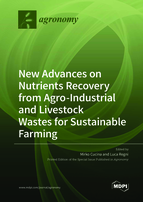New Advances on Nutrients Recovery from Agro-Industrial and Livestock Wastes for Sustainable Farming
A special issue of Agronomy (ISSN 2073-4395). This special issue belongs to the section "Farming Sustainability".
Deadline for manuscript submissions: closed (1 August 2021) | Viewed by 17245
Special Issue Editors
Interests: organic waste treatment; biopolymers; emerging contaminants; anaerobic digestion; composting; sewage sludge; bioplastics degradation
Special Issues, Collections and Topics in MDPI journals
Interests: in vitro culture; micropropagation; tree crops; agricultural byproduct valorization; sustainable agriculture; C sequestration; salt stress
Special Issues, Collections and Topics in MDPI journals
Special Issue Information
Dear Colleagues,
Fertilizers are critical to increasing the yield of crops and central to modern agriculture. Today, mineral fertilizers derived from non-renewable sources are the most widely used fertilizers in agriculture, even if they can represent a threat for the environment and a high cost for farmers. Agro-industrial and livestock wastes may be a sustainable source for the production of biobased fertilizers, which can represent low cost and environmentally friendly products. Different technologies are available to recover nutrients from organic wastes, but they are still not widespread on a large scale. The main limitations to nutrient recovery from agro-industrial and livestock wastes are related to negative characteristics of the waste streams (i.e., presence of emerging contaminants), technical issues in nutrient recovery, and limited knowledge on biobased fertilizer quality and effectiveness.
The aim of this Special Issue is to advance knowledge on (i) analysis of agro-industrial and livestock waste streams and potential for nutrient recovery and supply, (ii) technologies for nutrients recovery, (iii) quality of biobased fertilizers, (iv) laboratory and field assessment of biobased fertilizers, and (v) future challenges in nutrient recovery. Original research articles and concepts for review articles to address major issues are welcome.
Dr. Mirko Cucina
Dr. Luca Regni
Guest Editors
Manuscript Submission Information
Manuscripts should be submitted online at www.mdpi.com by registering and logging in to this website. Once you are registered, click here to go to the submission form. Manuscripts can be submitted until the deadline. All submissions that pass pre-check are peer-reviewed. Accepted papers will be published continuously in the journal (as soon as accepted) and will be listed together on the special issue website. Research articles, review articles as well as short communications are invited. For planned papers, a title and short abstract (about 100 words) can be sent to the Editorial Office for announcement on this website.
Submitted manuscripts should not have been published previously, nor be under consideration for publication elsewhere (except conference proceedings papers). All manuscripts are thoroughly refereed through a single-blind peer-review process. A guide for authors and other relevant information for submission of manuscripts is available on the Instructions for Authors page. Agronomy is an international peer-reviewed open access monthly journal published by MDPI.
Please visit the Instructions for Authors page before submitting a manuscript. The Article Processing Charge (APC) for publication in this open access journal is 2600 CHF (Swiss Francs). Submitted papers should be well formatted and use good English. Authors may use MDPI's English editing service prior to publication or during author revisions.
Keywords
- recycle
- organic waste
- manure
- nutrient recovery
- technologies for nutrient recovery
- anaerobic digestion
- digestate
- compost
- biobased fertilizer assessment
- environmental threats from biobased fertilizers







